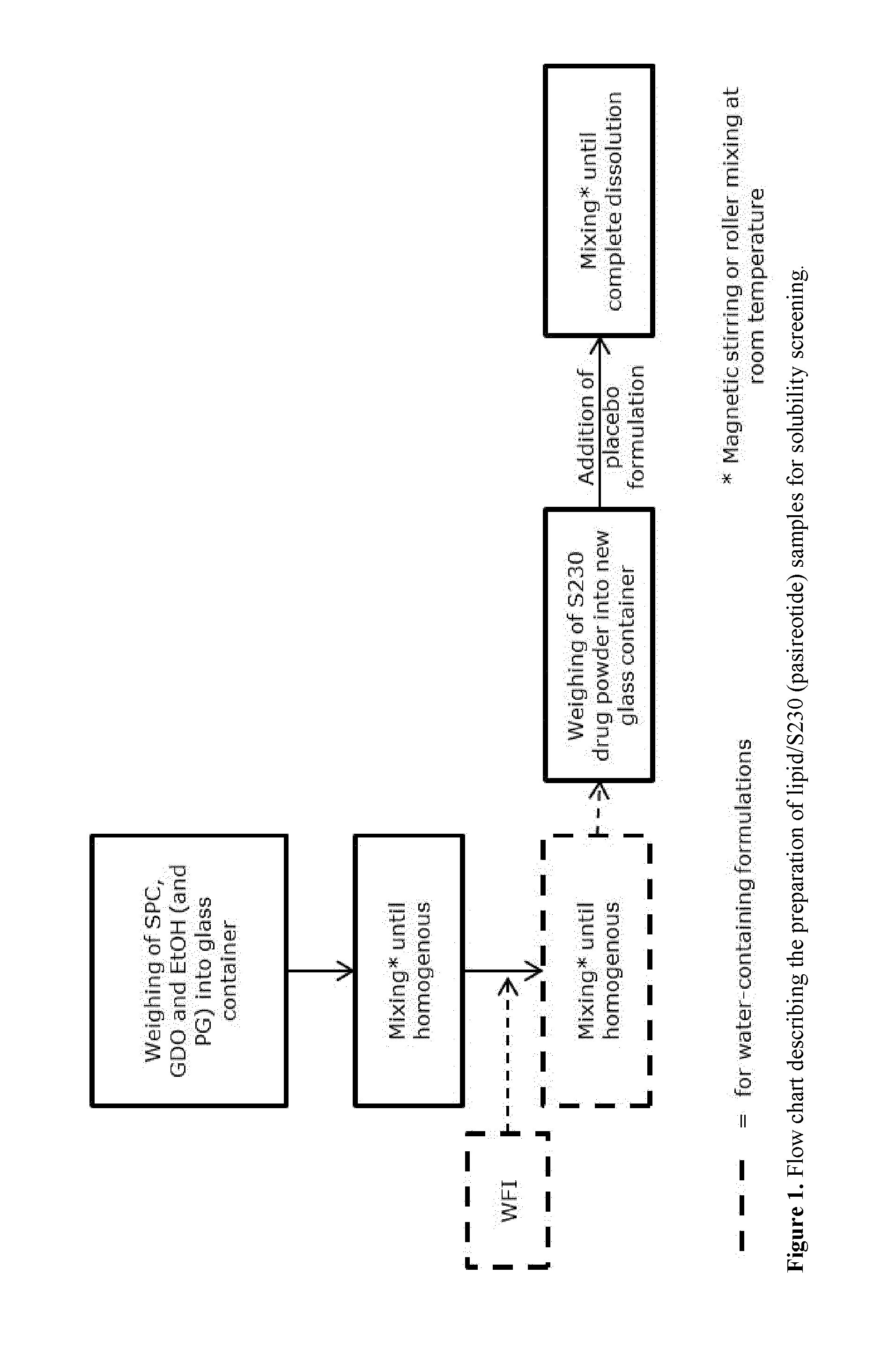Somatostatin receptor agonist formulations
a technology of somatostatin receptor and formulation, which is applied in the field of formulation precursors, can solve the problems of poor compliance, unsatisfactory or even dangerous effects, and general limited performance of administered peptide agents
- Summary
- Abstract
- Description
- Claims
- Application Information
AI Technical Summary
Benefits of technology
Problems solved by technology
Method used
Image
Examples
example 1
Solubility Screening
[0254]Placebo lipid mixture formulations as well as formulations of the single respective lipid alone were prepared in 1 OR vials according to Table 1. The sample size was 6 g. Samples of SOM230 (pasireotide pamoate) of the respective formulation type with a drug load of 3 wt % (corrected for peptide purity and content) were prepared in 2R vials, except for Formulation type 15 where only 1 wt % 5230 was evaluated. The samples were allowed to equilibrate at ambient room temperature; samples with formulation types 1-8 on end-over-end rotation and samples with formulation types 9-12 on magnetic stirring. The flow chart in FIG. 1 describes the sample preparation process. The screening covered the following formulation variables:[0255]Lipid weight ratio (SPC / GDO weight ratio)[0256]Co-solvent nature and concentration[0257]Single lipid formulations[0258]Single solvent (only PG)
TABLE 1Compositions of placebo lipid formulations(wt %) used for solubility screening.Formulat...
example 2
Injectability, Density and Viscosity
[0268]Formulations according to Table 3 were prepared and used for evaluation of injectability, density and viscosity. The lipid / SOM230 formulations with drug loads of 3 and 6 wt %, respectively, were prepared in 15R injection glass vials.
TABLE 3Compositions of lipid / SOM230 formulations (wt %).Sample IDSOM230*SPCDOPCGDOEtOHPGWFI4071S230-4.3140.3—40.47.57.5—1201-604071S230-4.3137.8—37.810.010.0—1201-614071S230-4.3137.8—37.810.1—10.01201-624071S230-8.5438.2—38.27.57.5—1201-634071S230-8.6135.7—35.710.010.0—1201-644071S230-8.6435.6—35.710.0—10.01201-654071S230-8.6034.7—34.712.0—10.01204-824071S230-8.6033.2—33.215.0—10.11204-83B4071S230-5.9139.55—39.557.507.50—1206-09B4071S230-7.3938.81—38.817.507.50—1206-10B4071S230-5.91—39.5539.557.507.50—1206-11B4071S230-5.9139.55—39.5510.005.00—1206-12*Pamoate salt; 4.3, 5.9, 7.4 and 8.6 wt % SOM230 pamoate salt corresponds to ca 30, 40, 50 and 60 mg SOM230 free base / g, respectively, when corrected for peptide puri...
example 3
Comparative Formulation Studies with SOM230 Acetate and SOM230 Hydrochloride
Preparation of SOM230 Hydrochloride
[0278]The SOM230 hydrochloride salt was prepared from SOM230 acetate using an ion exchange process. The ion exchange column was prepared by putting glass wool (HPLC grade) in the bottom of a 200 mL glass chromatography column from Sigma-Aldrich. A mixture of approximately 20 mL of Dowex 1×2 chloride form (Sigma-Aldrich) and distilled water (volume ratio 1:1) was added followed by a piece of glass wool on the top of the column. The column was rinsed with distilled water and the conductivity was measured. When the conductivity was below 35 μS / cm, a volume of 40 mL WFI was added to the column.
[0279]For the ion exchange, a SOM230 acetate (SOM230(Ac)) sample was prepared in a 100 mL Pyrex flask. The sample was diluted with WFI to a final volume of 65.55 mL and a concentration of 3.8 mg SOM230(Ac) / mL. The SOM230(Ac) solution was transferred to the ion exchange column using a plas...
PUM
| Property | Measurement | Unit |
|---|---|---|
| Fraction | aaaaa | aaaaa |
| Time | aaaaa | aaaaa |
| Percent by mass | aaaaa | aaaaa |
Abstract
Description
Claims
Application Information
 Login to View More
Login to View More - R&D
- Intellectual Property
- Life Sciences
- Materials
- Tech Scout
- Unparalleled Data Quality
- Higher Quality Content
- 60% Fewer Hallucinations
Browse by: Latest US Patents, China's latest patents, Technical Efficacy Thesaurus, Application Domain, Technology Topic, Popular Technical Reports.
© 2025 PatSnap. All rights reserved.Legal|Privacy policy|Modern Slavery Act Transparency Statement|Sitemap|About US| Contact US: help@patsnap.com



